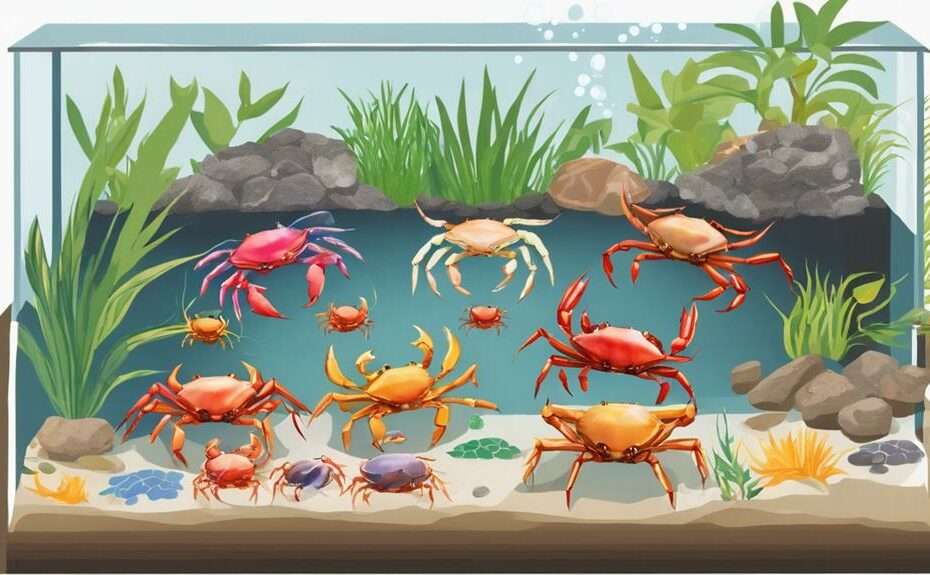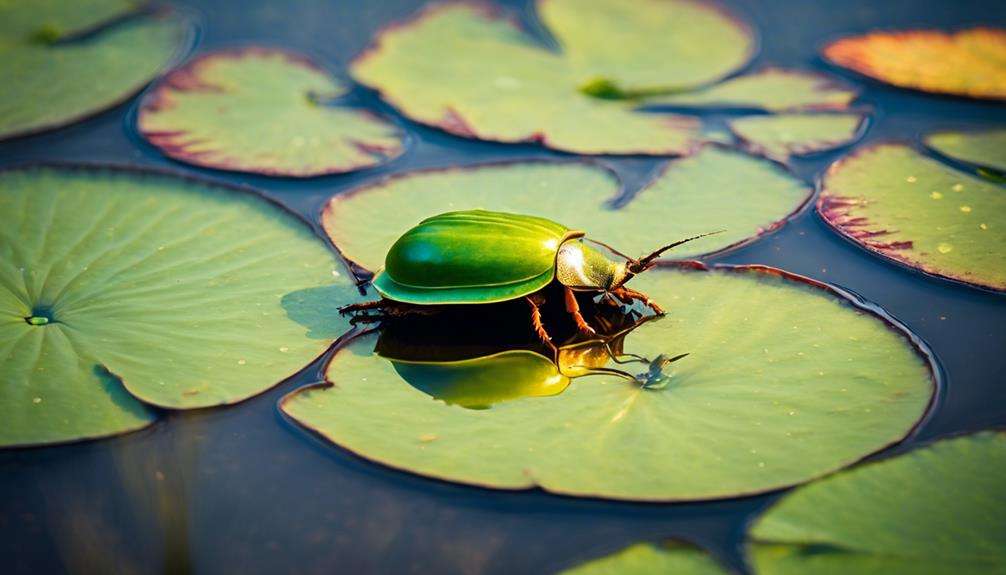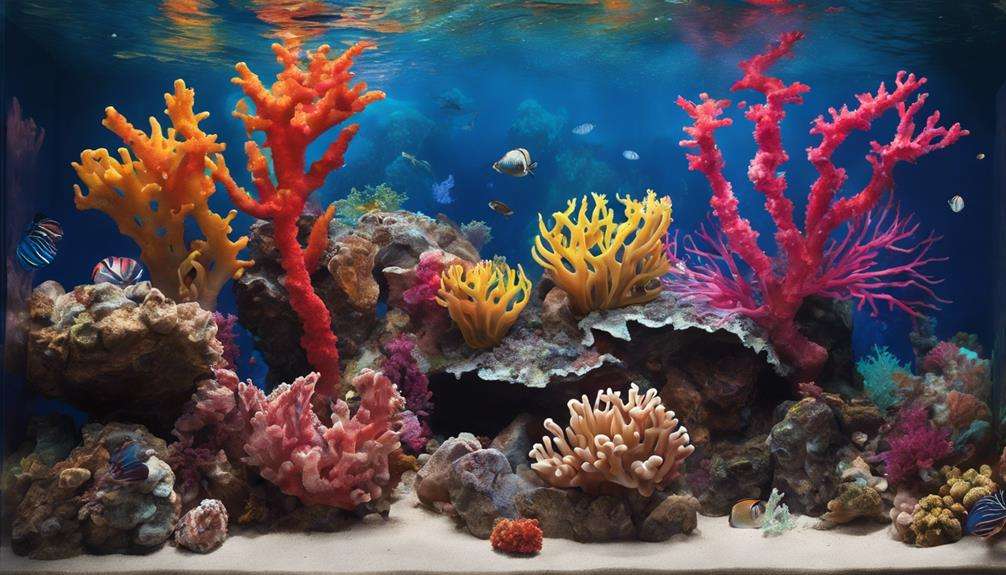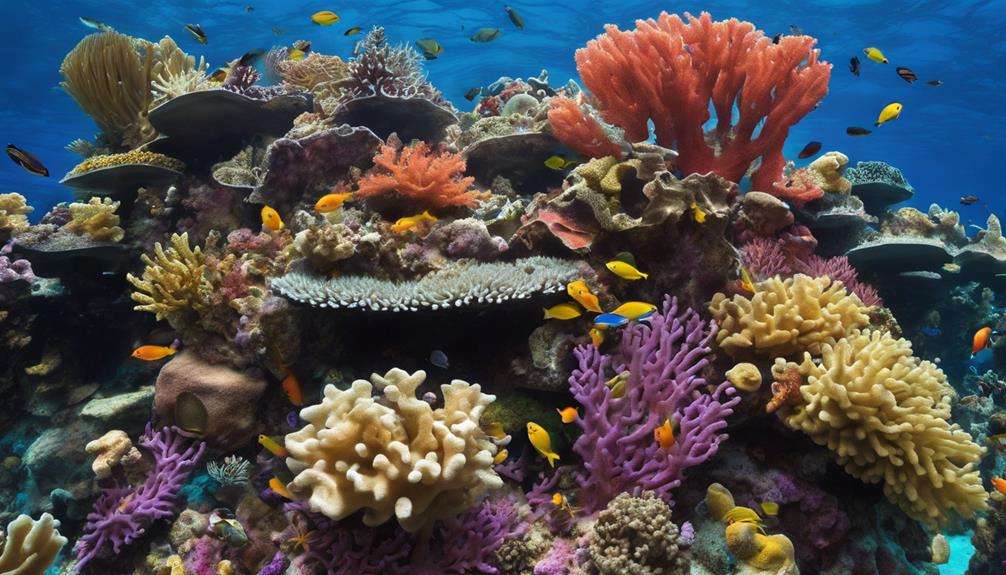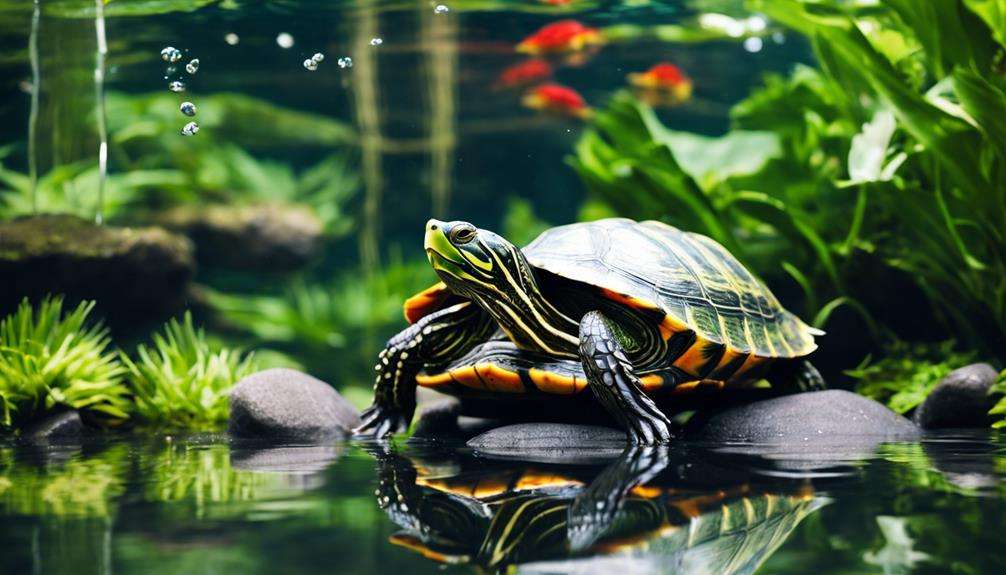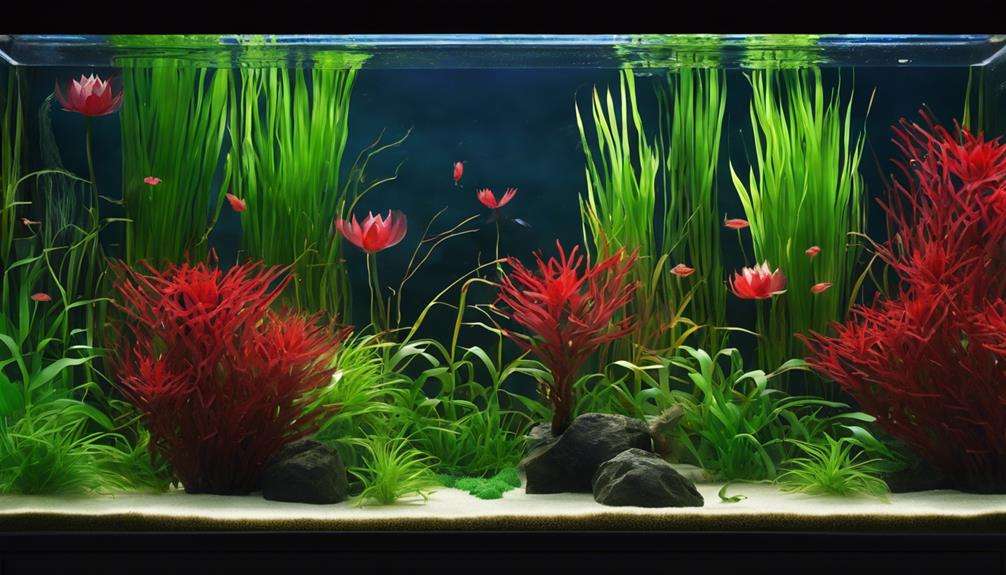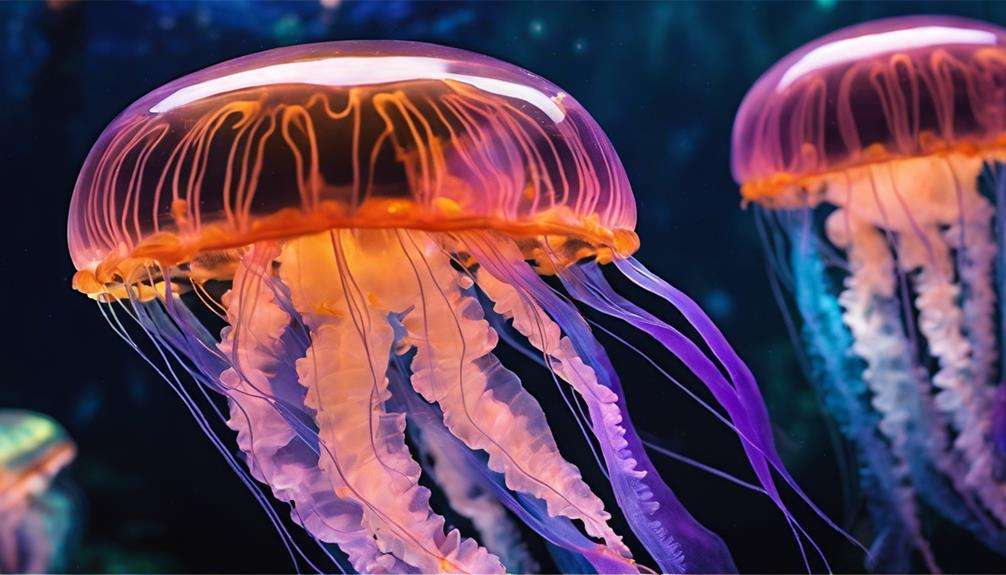Imagine your aquarium as a bustling metropolis, with freshwater crabs scuttling about like tiny mayors overseeing their domains.
Understanding the intricacies of caring for these miniature crustaceans can be both rewarding and challenging. From creating the perfect habitat to mastering their dietary needs, there's a whole world of knowledge waiting for you to explore.
Discover the secrets to nurturing these unique creatures and watch as your aquarium comes to life with their fascinating presence.
Key Takeaways
- Provide a minimum 5-gallon tank with hiding spots and climbing areas
- Offer a varied diet including flakes, pellets, and frozen foods
- Choose peaceful tank mates like guppies and snails
- Maintain stable water quality with regular testing and proper filtration
Freshwater Crab Habitat Requirements
To guarantee the well-being of freshwater crabs in your aquarium, a minimum tank size of 5 gallons is essential for their thriving captivity.
Creating a suitable habitat is critical for the overall health of freshwater crabs. Provide climbing areas, such as rocks or driftwood, for them to explore and molt safely. Hiding spots are also necessary to reduce stress, so incorporating caves or plants can offer security to these creatures.
Maintaining stable water quality is paramount. Regular water testing and changes are important to make sure the proper parameters for your freshwater crabs. Filtration systems should be efficient enough to keep the water clean without creating strong currents that could harm the crabs.
Temperature control is another critical factor in their care. Keep the water temperature within the recommended range to support their well-being. By carefully considering these habitat requirements, you can create a conducive environment where your freshwater crabs can thrive.
Tank Setup for Freshwater Crabs
When setting up the tank for freshwater crabs, make sure that the habitat includes suitable climbing areas and hiding spots for their well-being. A tank size of at least 5 gallons is recommended to provide ample space for these creatures. Decorate the freshwater aquarium with rocks and plants to create natural hiding places where the crabs can retreat and feel secure. Additionally, incorporating climbing areas such as driftwood or rocks will mimic their natural habitat and promote their physical activity.
Maintaining stable water conditions is important for the health of freshwater crabs. Proper filtration is necessary to keep the water clean and free from harmful substances that could endanger the crabs. Regular water testing and changes are essential to maintain good water quality. Be sure to secure the aquarium hood tightly to prevent any escape attempts by the crabs. By following these tank setup guidelines, you can create a suitable environment for your freshwater crabs to thrive.
Feeding Freshwater Crabs Properly
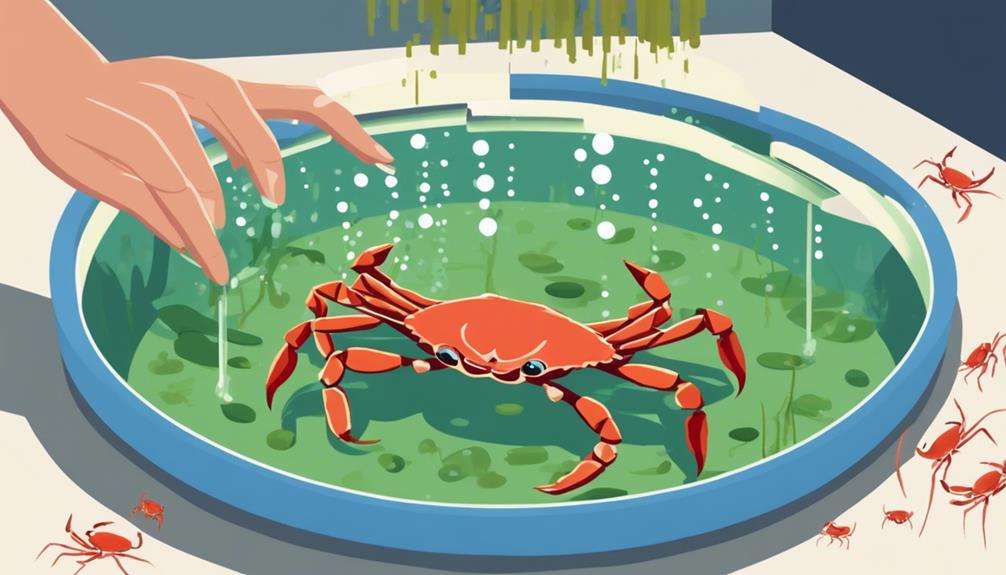
For best health and well-being, freshwater crabs require a varied diet that includes flakes, pellets, wafers, and frozen foods.
Freshwater crabs are omnivores, so it's important to provide them with a diverse range of foods to meet their nutritional needs. Their diet can consist of bloodworms, algae, vegetable wafers, and more to make sure they receive proper nutrition.
When feeding freshwater crabs frozen foods, make sure to thaw them beforehand to prevent any digestive issues that could arise from consuming food that's too cold. It's vital to make sure that the food reaches the bottom of the tank so that the crabs can easily access it.
Providing the appropriate food in the correct manner is crucial for the best health and well-being of freshwater crabs. Remember to offer a balanced diet to keep your freshwater crabs healthy and thriving in your aquarium.
Suitable Tank Mates for Freshwater Crabs
Introducing suitable tank mates for freshwater crabs involves selecting important fish species that coexist well with these crustaceans in your aquarium environment. Freshwater crabs can thrive alongside peaceful fish like guppies, tetras, and mollies. It's important to avoid aggressive or large fish that may harm or stress out the freshwater crabs.
Additionally, snails, shrimp, and small peaceful bottom-dwelling fish can make excellent tank mates for freshwater crabs. To maintain a harmonious environment, make sure that the tank mates you choose have similar water parameter requirements. Monitoring interactions between the freshwater crabs and their tank mates is important to prevent any aggression or stress.
Water Quality and Maintenance for Crabs
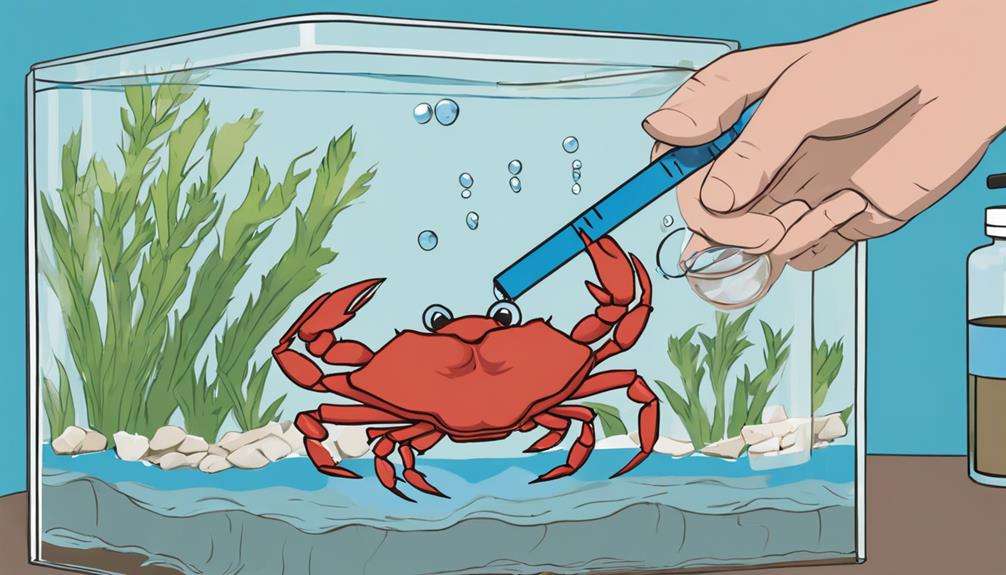
Regular monitoring and maintenance of water quality parameters are essential for ensuring the health and well-being of freshwater crabs in your aquarium.
It's important to monitor the salinity and pH levels weekly to maintain ideal conditions. Perform regular water changes to keep these levels stable, as fluctuations can stress the crabs.
Additionally, cleaning the substrate surface weekly helps remove debris and waste that can negatively impact water quality.
To prevent the buildup of harmful substances like ammonia and nitrites, conduct a thorough tank cleaning at least three times a year.
Remember that stable water parameters are important for the overall health of your freshwater crabs. By staying diligent with tank maintenance and monitoring salinity and pH levels, you provide a suitable habitat for your crabs to thrive.
Maintaining a clean and balanced environment will help ensure the longevity and well-being of your freshwater crab pets.
Handling Breeding of Freshwater Crabs
To successfully manage the breeding of freshwater crabs in your aquarium, understanding their specific reproductive behaviors and environmental requirements is essential. Freshwater crabs reproduce through mating, with females carrying eggs until hatching. Some species exhibit parental care, where mothers guard their offspring. Breeding behavior can vary between species, with some requiring specific conditions for successful reproduction.
Mating is an important aspect of the breeding process, and observing these behaviors can indicate successful reproduction. Providing specialized setups that mimic their natural habitat is important for encouraging breeding. Environmental conditions such as water quality, temperature, and hiding spots play a significant role in the breeding success of freshwater crabs.
Health and Care Tips for Freshwater Crabs
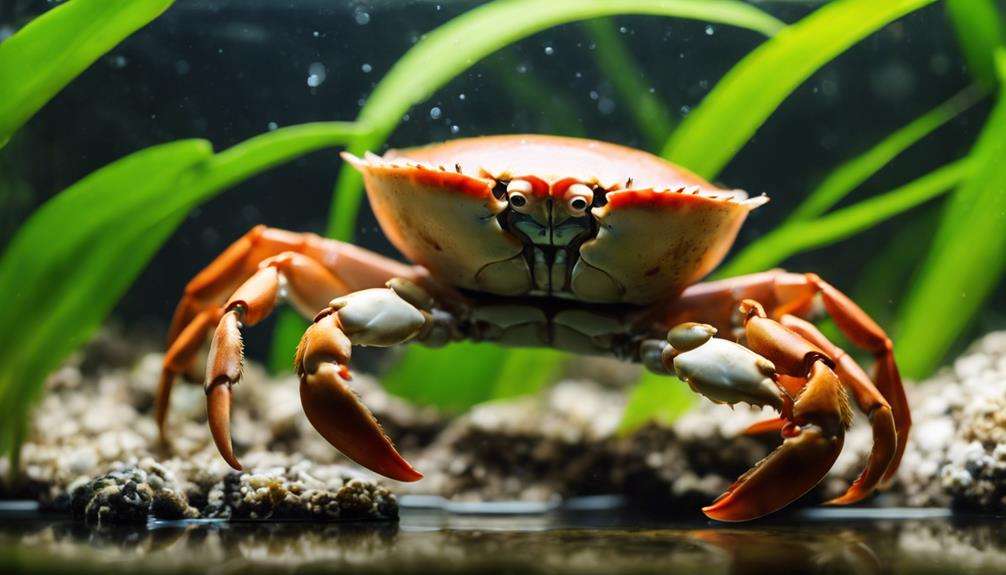
Guarantee the prime health and well-being of your freshwater crabs by closely monitoring water quality, cleanliness, and food intake on a regular basis. Maintaining ideal water parameters such as pH, temperature, and ammonia levels is essential for the health of freshwater crabs.
Make sure the aquarium is clean, with regular water changes to prevent the buildup of harmful substances. Freshwater crabs molt periodically to grow, so provide hiding spots and a secure environment during this vulnerable process.
If you notice any signs of illness in your freshwater crabs, seek veterinary care promptly. Handle the crabs gently to minimize stress and reduce the risk of injuries or diseases. Educate yourself on common diseases that affect freshwater crabs and the appropriate treatments available.
Unique Freshwater Crab Species
When it comes to unique freshwater crab species, a variety of visually stunning options are available for your aquarium.
Vampire Crabs boast a striking purple body with yellow accents, while Panther Crabs showcase vibrant orange and black coloration from Indonesia.
Patriot Crabs from West Africa exhibit vivid multi-colored patterns and are known for their territorial behavior.
Crab Species Overview
Freshwater crab species exhibit a diverse range of colors and behaviors, making them fascinating inhabitants for aquarium enthusiasts. The Vampire Crab, with its beautiful purple body and flashes of yellow, requires a 10+ gallon tank for 5-6 crabs.
The Panther Crab, originating from Indonesia, showcases bright orange and black coloration, feeding on invertebrate pellets and algae wafers. The Patriot Crab, a bright, multi-colored species from West Africa, displays territorial behavior and needs a 20-gallon tank for a single crab.
The Red Claw Crab, smaller in size at around 4 inches, is known for being excellent escape artists and requires a properly sealed tank. Panther Crabs have an average lifespan of 2-3 years in captivity, enjoying plenty of hiding places in the aquarium.
Habitat Requirements
For ideal care of distinctive freshwater crab species, ensuring their habitat requirements are met is essential to their well-being and longevity in captivity.
Vampire Crabs thrive in a tank size of at least 10 gallons for a group of 5-6 crabs.
Panther Crabs require numerous hiding spots in the aquarium to feel secure, while Patriot Crabs exhibit territorial behavior and need ample sand and mud for burrowing.
Red Claw Crabs, known for their escape artist skills, need vigilant containment in a secure tank due to their smaller size of around 4 inches.
Patriots, which can grow up to 6-8 inches across their carapace in captivity, necessitate a minimum of a 20-gallon tank for a single crab and 40+ gallons for two or more to accommodate their size and behavior effectively.
Feeding and Care
To guarantee the top health and well-being of distinctive freshwater crab species in your aquarium, providing a balanced and varied diet is essential.
Vampire Crabs thrive on a diet consisting of vegetables, baby crickets, and brine shrimp to vital nutrition.
Panther Crabs, known for their indiscriminate eating habits, benefit from invertebrate pellets and algae wafers in captivity.
Patriot Crabs enjoy a varied diet of vegetables, worms, pellets, and fish to maintain their health and vitality.
Red Claw Crabs, smaller in size at around 4 inches, require constant access to water to prevent dehydration.
Patriot Crabs, exhibiting territorial behavior, need ample sand and mud to burrow in their habitat, ensuring a comfortable and secure environment for your unique freshwater crab species.
Resources for Freshwater Crab Enthusiasts
You can enhance your knowledge of freshwater crab care by exploring essential topics like crab care essentials, habitat setup tips, and health and behavior guidelines. These resources can provide you with detailed information to guarantee the well-being of your freshwater crab pets.
Understanding these key points will help you create a suitable environment and provide appropriate care for your aquatic companions.
Crab Care Essentials
Freshwater crab enthusiasts seeking essential care resources can benefit from detailed information on tank size requirements and habitat preferences for various crab species.
Vampire Crabs, needing a minimum 10-gallon tank for 5-6 crabs, thrive with hiding places. Panther Crabs require ample hiding spots for their well-being. Patriot Crabs, known for territorial behavior, need sand and mud to burrow. Red Claw Crabs, being escape artists, necessitate a properly sealed tank due to their small size.
Patriots can grow up to 6-8 inches across the carapace, requiring a 20-gallon tank for a single crab and 40+ gallons for multiple. Understanding these essentials is important for the well-being of your freshwater crab companions.
Habitat Setup Tips
Enhance the habitat for your freshwater crabs by incorporating climbing areas, hiding spots, and vital water quality in the aquarium setup. For best thriving conditions, make sure a minimum tank size of 5 gallons to accommodate their needs adequately.
Decorate the habitat with rocks and plants to provide natural hiding places and climbing opportunities. Maintaining appropriate salinity levels and pH balance is essential for the health of freshwater crabs.
Implement proper filtration systems to keep the water clean and oxygenated, supporting the overall habitat quality. By creating a well-balanced environment with suitable climbing areas and hiding spots, you can enhance the well-being of your freshwater crabs while also enjoying their fascinating behaviors in the aquarium.
Health and Behavior
To understand the best health and behavior of freshwater crabs in your aquarium, it's important to provide a habitat that mimics their natural environment closely. Health in freshwater crabs is closely tied to proper filtration and water quality. Maintaining stable water conditions is essential for their well-being.
Freshwater crabs exhibit natural behaviors such as scavenging and climbing, so offering hiding places like rocks and plants in their habitat is necessary. Molting is a crucial process for their growth, and adult sizes can vary greatly. Ensure a secure aquarium hood to prevent escapes, as these nocturnal creatures are active and may wander at night.
Incorporating freshwater salt for species accustomed to low brackish levels can also support their health and behavior.
Frequently Asked Questions
What Do Freshwater Crabs Need in Their Tank?
To guarantee the well-being of freshwater crabs in their tank, provide adequate tank decorations for hiding and climbing, maintain a consistent feeding schedule, monitor essential water parameters, choose suitable tank mates, be mindful of the molting process, and handle with care.
How Do You Keep Fresh Water Crabs Alive?
To keep freshwater crabs alive, maintain proper water parameters, offer a diverse diet, provide suitable tank decorations, monitor molting, choose compatible tank mates, and handle with care. Following these guidelines guarantees the well-being of your freshwater crabs.
Do Freshwater Crabs Need a Filter?
You need to guarantee freshwater crabs have a filter in their tank. It maintains water quality, removes waste, and oxygenates the water. Different filters work for various tank sizes. Regular maintenance is essential for the crabs' well-being.
What Is the Lifespan of a Freshwater Crab?
In the wild, freshwater crabs typically live up to 10 years, but some species may only reach around 3 years. Factors like diet, habitat conditions, and stress levels influence their lifespan.
Conclusion
Now that you have mastered the art of caring for freshwater crabs in your aquarium, remember to maintain a delicate balance of habitat requirements and proper feeding.
By ensuring a suitable tank setup, providing a varied diet, and monitoring water quality diligently, you can witness these unique creatures thrive in their environment.
Keep in mind the importance of tank mates, breeding practices, and overall health tips to continue enjoying the fascinating world of freshwater crab care.
